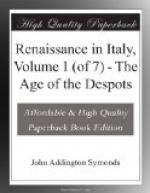Nothing is more characteristic of the sharp contrasts of the Italian Renaissance than the emergence not only from the same society, but also from the bosom of the same Church, of two men so diverse as the Pope Alexander VI. and the Prophet Girolamo Savonarola. Savonarola has been claimed as a precursor of the Lutheran Reformers, and as an inspired exponent of the spirit of the fifteenth century. In reality he neither shared the revolutionary genius of Luther, which gave a new vitality to the faiths of Christendom, nor did he sympathize with that free movement of the modern mind which found its first expression in the arts and humanistic studies of Renaissance Italy. Both toward Renaissance and Reform he preserved the attitude of a monk, showing on the one hand an austere mistrust of pagan culture, and on the other no desire to alter either the creeds or the traditions of the Romish Church. Yet the history of Savonarola is not to be dissociated from that of the Italian Renaissance. He more clearly than any other man discerned the moral and political situation of his country. When all the states of Italy seemed sunk in peace and cradled in prosperity, he predicted war, and felt the imminence of overwhelming calamity. The purification of customs which he preached was demanded by the flagrant vices of the Popes and by the wickedness of the tyrants. The scourge which he prophesied did in fact descend upon Italy. In addition to this clairvoyance by right of which we call him prophet, the hold he took on Florence at a critical moment of Italian history is alone enough to entitle him to more than merely passing notice.
Girolamo Savonarola was born at Ferrara in 1452.[1] His grandfather Michele, a Paduan of noble family, had removed to the capital of the Este princes at the beginning of the fifteenth century. There he held the office of court physician; and Girolamo was intended for the same profession. But early in his boyhood the future prophet showed signs of disinclination for a worldly life, and an invincible dislike of the court. Under the House of Este, Ferrara was famous throughout Italy for its gayety and splendor. No city enjoyed more brilliant and more frequent public shows. Nowhere did the aristocracy maintain so much of feudal magnificence and chivalrous enjoyment. The square castle of red brick, which still stands in the middle of the town, was thronged with poets, players, fools who enjoyed an almost European reputation, court flatterers, knights, pages, scholars and fair ladies. But beneath its cube of solid masonry, on a level with the moat, shut out from daylight by a sevenfold series of iron bars, lay dungeons in which the objects of the Duke’s displeasure clanked chains and sighed their lives away.[2] Within the precincts of this palace the young Savonarola learned to hate alike the worldly vices and the despotic cruelty against which in after-life he prophesied and fought unto the death.
[1] In this chapter on Savonarola I have made use of Villari’s Life (translated by Leonard Horner, Longmans, 1863, 2 vols.), Michelet’s Histoire de France, vol. vii., Milman’s article on Savonarola (John Murray, 1870), Nardi’s Istoria Fiorentina, book ii., and the Memoirs of De Comines.
[2] See p. 424.




